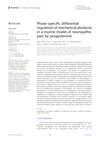Search
forLearn
1 / 1 resultsResearch
5 / 912 resultsresearch Possible Involvement of 5α-Reduced Neurosteroids in Adrenergic and Serotonergic Stimulation of GFAP Gene Expression in Rat C6 Glioma Cells
5α-reduced neurosteroids may help regulate glial cell differentiation.
research Nestin-Positive Hair Follicle Pluripotent Stem Cells Can Promote Regeneration of Impinged Peripheral Nerve Injury
Hair follicle stem cells can help repair nerve injuries.
research Histone Deacetylase Inhibitors Promote Neurosteroid-Mediated Cell Differentiation and Enhance Serotonin-Stimulated Brain-Derived Neurotrophic Factor Gene Expression in Rat C6 Glioma Cells
HDAC inhibitors help brain cells grow and improve brain function.

research Differentiation of Nestin-Negative Human Hair Follicle Outer Root Sheath Cells Into Neurons In Vitro
Human hair follicle cells can be turned into neural stem cell-like cells, which might help treat brain diseases.

research Phase-Specific Differential Regulation of Mechanical Allodynia in a Murine Model of Neuropathic Pain by Progesterone
Progesterone initially worsens but later reduces neuropathic pain in mice, through different mechanisms.
Community Join
2 / 2 resultscommunity Please explain this Minoxidil phenomena
The post discusses the difference in effects of Minoxidil (Min) on scalp and facial hair. The user questions why Min-induced hair growth on the scalp is temporary, while facial hair growth seems permanent, even after stopping Min. They propose theories, including different Min mechanisms on body and facial hair, the role of DHT, and the possibility of not achieving fully terminal hair. The responses include personal experiences and theories about Min's effects on hair growth.
community Why do people here trust Kevin Mann?
Concerns about finasteride's side effects on neurosteroids and brain health, with skepticism towards Kevin Mann's advice. Users discuss using finasteride, minoxidil, and RU58841 for hair loss, with mixed opinions on their safety and effectiveness.